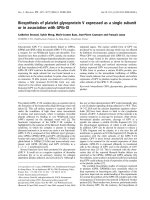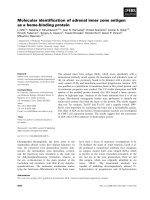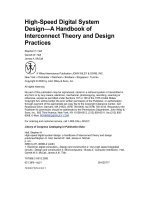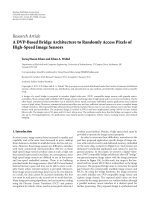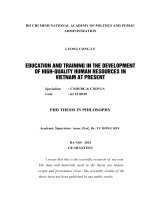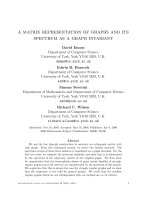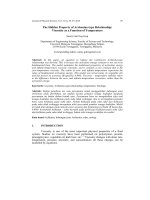Development of high speed video imaging as a process analytical technology (PAT) tool
Bạn đang xem bản rút gọn của tài liệu. Xem và tải ngay bản đầy đủ của tài liệu tại đây (12.74 MB, 208 trang )
DEVELOPMENT OF HIGH SPEED VIDEO IMAGING AS A
PROCESS ANALYTICAL TECHNOLOGY (PAT) TOOL
WANG LIKUN
(B.Eng. (Hons.),Zhejiang University)
A THESIS SUBMITTED
FOR THE DEGREE OF DOCTOR OF PHILOSOPHY
DEPARTMENT OF PHARMACY
NATIONAL UNIVERSITY OF SINGAPORE
2010
i
ACKNOWLEDGEMENTS
First, I would like to express my appreciation to Associate Professor Paul
Heng and Dr. Celine Liew. This thesis would have not been possible without
their patient guidance, inspiration and strong support from the initial to the
final level. I learnt not only knowledge but also visions from them.
I am grateful to be a recipient of National University of Singapore (NUS)
research scholarship, which supported my postgraduate life in Singapore in the
last 4 years and allowed me to focus on my research work.
It is a pleasure for me to express thanks to Ms Teresa Ang and Ms Wong Mei
Yin, who have consistently provided technical support in the last 4 years. I
owe my deep gratitude to Dr. Elaine Tang, who gave valuable advice,
guidance and encouragement in the initial stage of my PhD work. I also would
like to thank Mr. Yeo Eng Hee from NUS Computer Centre for his dedication
in the maintenance of the Matlab distributed computing clusters.
I am indebted to many of my colleagues and friends for their invaluable
support and for making my postgraduate life more interesting and memorable.
Last but not least, I would like to show my gratitude to my family, especially
Iris, for their love.
Likun, September 2010
ii
TABLE OF CONTENTS
ACKNOWLEDGEMENTS i
SUMMARY vi
LIST OF TABLES vii
LIST OF FIGURES viii
LIST OF SYMBOLS xiii
CHAPTER 1. INTRODUCTION 1
1.A. Overview of multiparticulate dosage forms 4
1.B. Manufacture of multiparticulate dosage forms 6
1.B.1. Pelletization 6
1.B.1.1. Extrusion-spheronization 7
1.B.1.3. High shear pelletization 11
1.B.1.4. Hot melt extrusion 13
1.B.2. Coating of pellets 14
1.B.2.1. Top spray fluid bed coating 14
1.B.2.2. Bottom spray fluid bed coating 16
1.B.2.3. Tangential spray fluid bed coating 18
1.B.2.4. Huttlin™ fluid bed coating 19
1.C. Quality frameworks for solid dosage form manufacture 20
1.C.1. Quality by test 20
1.C.2. Quality by design 21
1.D. Process analytical technologies 22
1.D.1. General control theory 23
1.D.2. Classification of process analyzers 25
1.D.3. Roles of in-process material flow pattern in pharmaceutical processes 27
1.D.4. Visiometric process analyzer & its potential applications 28
1.E. Research gaps in extrusion-spheronization 31
1.E.1. Particle growth kinetics of spheronization process 33
1.E.2. Relationship between particle motion in the near plate region and particle
growth kinetics 36
1.E.3. Relationship between bed surface flow pattern and particle growth kinetics
36
1.F. Research gaps in bottom spray fluid bed coating 37
1.F.1. Particle recirculation within the partition column 38
1.F.2. The mechanism of particle recirculation within the partition column 40
1.F.3. Particle mass flow rate 40
1.F.4. Annular bed flow pattern 41
iii
CHAPTER 2. HYPOTHESIS AND OBJECTIVES 43
2.A. Hypothesis 44
2.B. Objectives 45
CHAPTER 3. EXPERIMENTAL WORKS 48
3.A. Material 49
3.A.1. Materials for extrusion-spheronization 49
3.A.2. Materials for bottom spray fluid bed coating study 49
3.B. Development of visiometric process analyzer 49
3.B.1. High speed video imaging 50
3.B.2. Particle image velocimetry 50
3.B.3. Morphological image processing 53
3.C. Methods for investigations on the spheronization process 55
3.C.1. Extrusion-spheronization 55
3.C.2. Determination of particle growth kinetics during spheronization 56
3.C.2.1. High speed video imaging 56
3.C.2.2. Particle sizing using Ferret diameter determination of in-process high
speed images 58
3.C.2.3 Verification of Ferret diameter measurement 58
3.C.3. Quantification of particle motion in the near plate region in relation to
particle growth kinetics and mechanisms 60
3.C.3.1. Development of visiometric process analyzer 60
3.C.3.2. Calculation of mean particle speed () and granular temperature
() in the near plate region 60
3.C.3.3. Visualization of total mean speed () and total mean granular
temperature () in the near plate region 62
3.C.3.4. Particle speed distribution within the fluidization zone 64
3.C.4. Quantification of bed surface flow pattern in relation to particle growth
kinetics 65
3.C.4.1. Development of visiometric process analyzer 65
3.C.4.2. Visualization of bed surface flow pattern and particle growth kinetics
using 3D scatter plot 67
3.D. Methods for investigations on bottom spray fluid bed coating process 67
3.D.1. Development of visiometric process analyzer for quantification of particle
recirculation probability within the partition column 67
3.D.1.1. High speed video imaging of particles moving within the partition
column 67
3.D.1.2. Morphological image processing 68
3.D.1.3. Ensemble correlation PIV 69
3.D.1.4. Verification of particle displacement PDF by image tracking 70
3.D.2. Mechanisms of particle recirculation within the partition column 71
3.D.2.1. Base-coating of sugar pellets 71
3.D.2.2. Configuration of visiometric process analyzer for quantification of
particle recirculation probability within the partition column 71
3.D.2.3. Estimation of voidage within the partition column 73
3.D.2.4. Air velocity measurement 74
3.D.2.5. Single particle terminal velocity calculation 75
3.D.2.6. Assessment of the extent of spray drying effect during coating 76
iv
3.D.3. Development of visiometric process analyzer for particle mass flow rate
measurement in the fountain region 77
3.D.4. Influence of annular bed flow patterns on coat uniformity 79
3.D.4.1. Production of seed pellets for high speed video imaging 79
3.D.4.2. Development of visiometric process analyzer for annular bed detection
79
3.D.4.3. Measurement of particle recirculation probability within the partition
column 80
3.D.4.4. Characterization of coating performance using colour coating and
tristimulus colourimetry 80
3.D.4.4.1. Colour coating 80
3.D.4.4.2. Tristimulus colourimetry and statistical analysis of colour variance
of in-process samples 81
CHAPTER 4. RESULTS AND DISCUSSION 84
4.A. Particle growth kinetics in the spheronization process 85
4.A.1. Verification of Ferret diameter measurement technique for particle size
distribution determination 85
4.A.2. Refined model for particle growth kinetics 88
4.B. Relationship between particle motion in the near plate region and particle
growth kinetics 93
4.B.1. “Dual kinetic zones” particle flow structure in the near plate region 93
4.B.2. Relationship between mean speed profile in the near plate region and
particle growth kinetics 95
4.B.3. Relationship between mean granular temperature profile and particle growth
kinetics in the near plate region 99
4.B.4. Particle speed distribution within the fluidization zone 102
4.C. Relationship between bed surface flow pattern and particle growth kinetics
during spheronization 107
4.C.1. Effect of velocity vector filtering 107
4.C.2. Relationship between bed surface mean speed and particle growth kinetics
109
4.C.3. Possibility of using of bed surface flow pattern for spheronization process
monitoring 112
4.D. Development of visiometric process analyzer for quantifying particle
recirculation within the partition column of the bottom spray fluid bed coater
113
4.D.1. Advantages of visiometric process analyzer for quantifying particle
recirculation probability 113
4.D.2. Samples of original and pre-processed high speed images 113
4.D.3. Effect of ensemble correlation PIV 114
4.D.4. Particle displacement probability density function verification by image
tracking 115
4.D.5. Use of particle displacement PDF data 118
4.D.6. Integration of visiometric process analyzers with current feedback process
analyzers 120
4.E. Mechanism of particle recirculation within the partition column of the
bottom spray fluid bed coater 121
4.E.1. High speed images within the partition column 121
v
4.E.2. Effects and verification of particle number measurement 123
4.E.3. Recirculation probability and voidage measurement within the partition
column 125
4.E.4. Air velocity within partition column, single particle terminal velocity and
boundary layer thickness 127
4.E.5. Effects of meso-scale flow structure on drag force 129
4.E.6. Origins of cluster formation and breakage 131
4.E.7. Comparison with circulating fluidized bed studies 132
4.E.8. The extent of spray drying effect 134
4.E.9. Influences of cluster formation on coating process 135
4.E.10. Control of cluster formation within the partition column 137
4.F. Development of a visiometric process analyzer for measuring particle mass
flow rate in the fountain region 138
4.F.1. PIV and morphological image processing results 138
4.F.2.Comparative advantages of measuring downward moving particles 139
4.F.3.Using visiometric process analyzer to investigate the role of partition gap and
AAI 140
4.F.3.1. The dual role of partition gap 140
4.F.3.2. AAI diameter - the effectiveness of Venturi effect 141
4.F.4. Uses and integration of online MFR measurement 143
4.G. The influence of annular bed flow pattern on coat uniformity 144
4.G.1. Annular bed flow patterns detected using visiometric process analyzer 145
4.G.2. Coat uniformity of in-process samples 147
4.G.3. Influences of particle recirculation within partition column and particle
mass flow rate on coat uniformity 149
4.G.4. Influence of annular bed flow patterns on coat uniformity 151
4.G.5. Significance of annular bed flow pattern 154
4.G.6. Feasibility of monitoring annular bed flow pattern in large scale coating
process 157
CHAPTER 5. CONCLUSION 162
5.A. Spheronization process 163
5.B. Bottom spray fluid bed coating 164
5.C. Limitations and future directions 164
REFERENCES 167
LIST OF PUBLICATIONS 188
vi
SUMMARY
This PhD project explored the development of high speed video imaging as a
process analytical technology (PAT) tool for better understanding and control
of two major multiparticulate manufacturing processes, i.e. extrusion-
spheronization and bottom spray fluid bed coating. Particle image velocimetry
and image processing were employed for analysis of high speed images to
elucidate in-process material flow pattern. From the investigations on the
spheronization process, a refined model of particle growth kinetics was
proposed. The particle flow patterns in the near frictional base plate region and
bed surface were investigated and correlated with particle growth kinetics. It
was found that spheronization process monitoring and endpoint determination
could be achieved by monitoring particle motion either in the near plate region
or in the spheronization bed surface. In the investigations on bottom spray
fluid bed coating, the particle motion in the upbed region, fountain region and
annular bed region were quantified. With the developed PAT tool, cluster
formation and drag reduction were found to be the mechanisms of particle
recirculation within the partition column. Real-time measurement of particle
mass flow rate was achieved. The influences of annular bed flow patterns on
coat uniformity were also clearly demonstrated for the first time.
vii
LIST OF TABLES
No.
Title
Page
Table 1.
Process conditions for high speed video imaging of
particle motion in the partition column of the Precision
coater
72
Table 2.
Process conditions for determining the extent of spray
drying effect
77
Table 3.
Process parameters for MFR measurement
78
Table 4.
Process conditions for high speed video imaging and
colour coating
79
Table 5.
Comparison between the riser of the circulating fluid
bed and the partition column of the bottom spray fluid
bed coater
134
Table 6. Comparison between characteristics of clusters found
in this investigation and those from previous reports on
the circulating fluid bed
134
Table 7.
Two-sample F-test results for dE variance of in-process
samples
150
viii
LIST OF FIGURES
No.
Title
Page
Figure 1.
Role of PAT under QbD framework
3
Figure 2. Schematic diagram of (A) single screw axial extruder,
(B) counter rotating twin-screw extruder, (C) single
screw radial extruder, (D) Nica
TM
extruder, (E) rotary-
cylinder extruder, (F) rotary-gear extruder and (G) ram
extruder
9
Figure 3. Schematic diagrams of frictional base plates with (A)
cross-hatched and (B) radial geometric patterns
10
Figure 4.
(A) Rotary processor in the pelletization mode, (B)
rotary processor in drying/coating mode, (C) high shear
pelletizer and (D) hot melt extruder
12
Figure 5.
Schematic diagram of (A) top spray, (B) bottom spray
(Wurster), (C) Precision, (D) tangential, (E)
FlexStream
TM
and (F) Huttlin
TM
fluid bed coaters
15
Figure 6.
Schematic diagram for ideal process control
24
Figure 7.
Combination of feedback and feedforward controllers
for practical pharmaceutical process control (adapted
from Koenig, 2009)
25
Figure 8.
Schematic diagram showing the principles of PIV
30
Figure 9.
Particle growth kinetics for spheronization process
proposed by (A) Rowe, (B) Baert et al. and (C) Liew et
al.
34
Figure 10.
(A) Ideal particle motion without recirculation, (B)
actual particle motion joining recirculation within the
partition column
39
Figure 11.
Schematic diagram of Matlab distributed computing
cluster (adapted from the MathWorks, 2010)
52
ix
Figure 12.
(A) Perspective view of spheronizer, (B) product
discharge slot used for high speed video imaging, (C)
high speed video imaging during spheronization process
and (D) time sequence for high speed video imaging
56
Figure 13.
Images of (A) heat sink and cooling fan unit, and (B)
10×10 LED array mounted on the bottom of the heat
sink
57
Figure 14. Schematic diagram of high speed video imaging of
spheronization bed surface
65
Figure 15.
Schematic representation of high speed video imaging
system setup for capturing particle movement in the
bottom spray fluid bed coater
68
Figure 16.
Flow chart of image pre-processing for images of
moving particles in the partition column of the bottom
spray fluid bed coater
69
Figure 17.
Procedure for ensemble correlation PIV
70
Figure 18.
(A) Time sequence for high speed video imaging of
particle motion in the partition column, (B) schematic
diagram of AAI with diameter of d mm
72
Figure 19. Flow chart depicting different steps in obtaining the
number of particles on the image
74
Figure 20. Schematic diagram of air velocity measurement within
the partition column of the Precision coater
75
Figure 21.
Schematic diagram showing the volume captured by the
high speed camera for MFR measurement
77
Figure 22.
Particle size distributions measured using (A) optical
microscope and Ferret mean diameter and (B) high
speed imaging and Ferret diameter determination
86
Figure 23.
Changes in particle size distributions during
spheronization
89
Figure 24.
Schematic diagrams of (A) refined particle growth
kinetics and (B) the influences of shear energy input and
material plasticity on particle growth kinetics
91
x
Figure 25.
Sample high speed image of particle movement in the
near plate region showing the “dual kinetic zones”
particle flow structure
95
Figure 26. Sample dimensionless plots of (A) particle mean speed
and (B) granular temperature showing the kinetic zones,
and of the dimensionless distances corresponding to the
end of (C) initial drop in mean speed and (D) the initial
surge in granular temperature
96
Figure 27.
Changes in the mean speed profile in the near plate
region with respect to spheronization time and
dimensionless distance from the frictional base plate
98
Figure 28.
Changes in mean granular temperature profile in the
near plate region with respect to spheronization time and
dimensionless distance from the bottom of frictional
base plate
100
Figure 29.
Particle speed distributions in the fluidization zone with
spheronization time
103
Figure 30.
Schematic diagram of collisions between (A) coarse and
fine particles and (B) coarse and coarse particles
104
Figure 31.
Changes in particle speed distributions during the
spheronization process (dots) and the fitness to Maxwell
(dotted lines) and Gaussian (solid lines) distributions,
respectively
105
Figure 32.
(A) Decomposition of relative velocity and (B)
schematic diagram showing elastic, inelastic and highly
inelastic collisions
107
Figure 33.
Sample results from the different steps of velocity vector
filtering to detect the ring shaped spheronization bed
surface
108
Figure 34.
Changes in bed surface mean speed with respect to
spheronization time and mean particle size
110
Figure 35.
(A) Sample of original image from high speed video
clips (recording speed: 4219 fps), (B) sample of pre-
processed image (air flow rate: 90 m
3
/h, atomizing air
pressure: 1.5 bar)
114
xi
Figure 36.
Correlation results from (A) a single pair of frames, (B)
20 image pairs, (C) 100 image pairs, and (D) 500 image
pairs
115
Figure 37.
Contour plots of particle displacement PDF from (A)
ensemble correlation PIV results without image pre-
processing, (B) validation data after tracking of 1000
randomly selected particles and (C) ensemble correlation
PIV result after image pre-processing
117
Figure 38.
(A) Particle velocity magnitude histograms under
atomizing air pressure of 1.5 bar and air flow rates of (i)
80 m
3
/h, (ii) 90 m
3
/h, (iii) 100 m
3
/h; and (B) particle
velocity orientation histograms under atomizing aire
pressure of 1.5 bar and air flow rates of (i) 80 m
3
/h, (ii)
90 m
3
/h, (iii) 100 m
3
/h
119
Figure 39. High speed images showing aggregate formation within
the partition column
122
Figure 40.
Flow chart with sample images depicting the different
steps in morphological image processing for particle
number measurement
124
Figure 41.
Verification (○) and morphological image processing
results (∆) for particle number detection
125
Figure 42.
(A) Particle recirculation probability and (B) average
voidage within the partition column for (i) 355-425 µm,
(ii) 500-600 µm and (iii) 710-850 µm particles
126
Figure 43.
Time series (A) particle recirculation probability, (B)
voidage and (C) vertical velocity component of (i) 355-
425 µm, (ii) 500-600 µm and (iii) 710-850 µm particles,
respectively
128
Figure 44.
Air velocity measurement results within the partition
column
129
Figure 45.
Schematic diagram of a typical circulating fluid bed
133
Figure 46. The extent of spray drying effect of particles with three
different size fractions
135
xii
Figure 47. Schematic diagram showing particle movement and air
flow (A) with clustering and (B) without clustering in
the partition column of bottom spray fluid bed coater
136
Figure 48. (A) Sample high speed image and (B) sample PIV
results for MFR measurement
138
Figure 49.
(A) Influences of partition gap and air flow rate on
particle MFR; (B) influences of atomizing air pressure
and AAI diameter on particle MFR
141
Figure 50.
Sample high speed image of annular bed flow
145
Figure 51.
(A) Sample PIV results of annular bed flow using (i)
AAI-20, (ii) AAI-24 and (iii) AAI-30; (B) sample
streamlines from PIV results using (i) AAI-20, (ii) AAI-
24 and (iii) AAI-30
146
Figure 52.
(A) Trends of mean colour difference (
) and (B) mean
relative colour variation (RCV) of in-process samples
obtained from AAI-20, AAI-24 and AAI-30
147
Figure 53.
Schematic representation of annular bed flow regimes
with their influences on coating performance
157
Figure 54.
PIV results from 10 cm by 10 cm observation window of
(A) global fluidization, (B) localized fluidization and (C)
plug flow at time point of (i) 0 ms, (ii) 20 ms and (iii) 40
ms
158
Figure 55.
Scatter plot of time series velocity vectors from three
randomly chosen locations (i, ii and iii) under (A) global
fluidization, (B) localized fluidization and (C) plug flow
159
xiii
LIST OF SYMBOLS
a
Parameter to be fitted in Maxwell distribution
,
,
,
,
,
Parameter to be fitted in Gaussian distribution
AAI Air accelerator insert
ANOVA Analysis of variance
b
Structuring element
c
i
The fluctuating speed of the i
th
speed with respect to the
mean speed
c
II
(Δx,Δy)
2D cross-correlation coefficient at displacement
of(Δx,Δy)
dE
Colour difference in the CIE Lab colour space
A position that is
mm away from the frictional base
plate
d
p
Particle diameter (µm)
C
D
Drag coefficient of a single particle
C
MQD
(Δx,Δy)
Quadratic difference at the displacement of(Δx,Δy)
The mean colour difference
D
Position matrix
D
b
Domain of structuring element b
DC Direct current
D
e
Diameter of partition column
DoE Design of experiments
Unit vector pointing from particle #2 to particle #1
xiv
E
Mean operator
E(t)
Mean particle cycle-time (s)
f
Digital image for morphological image processing
Gray-scale dilation
Gray-scale erosion
Gray-scale opening
fps Frames per second
FBRM Focused beam reflectance measurement
F
D
Drag force (N)
F
d0
The drag force without considering multi-particle effect
FDA Food and Drug Administration
F
deff
The effective drag force when multi-particle effect is
considered
Normal component of
with respect to
Tangential component of
with respect to
g
Acceleration of gravity (9.81 m
2
/s)
GT
Granular temperature
GT
t
Granular temperature of near plate region at time t
(1 vector)
A matrix containing
of all 30 time points during
spheronization (30 matrix)
H
Digital image after thresholding
HPMC Hydroxypropyl methylcellulose
xv
I
The first digital image of the image pair for PIV
analysis
I'
The second digital image of the image pair for PIV
analysis
I(i,j)
Intensity of pixel located at (i,j) of image I
Κ
Extent of spray drying effect (%)
LED Light emitting diode
(L
c
, a
c
, b
c
)
The colour of coated particle in CIE Lab colour space
(L
u
, a
u
, b
u
)
The colour of uncoated particle in CIE Lab colour space
M
Mass of a single particle (g)
m
c
The weight of dry coating material applied to particles
m
f
The final particle weight after coating (g)
m
i
The initial particle weight before coating (g)
mpz
t
The mean particle size at time
M
Number of pixels along vertical direction of template
M
t
Load of particles (g)
MCC Microcrystalline cellulose
MFR Mass flow rate (g/s)
MQD Minimum quadratic difference
N
The number of particles used in colourimetry
N
Number of pixels along horizontal direction of template
N
p
Particle number
xvi
NIR Near infrared
Probability of particles with certain speed
PAT Process analytical technologies
PDF Probability density function
PEPT Positron emission particle tracking
PFFR Particle-fluid flow ratio
PID Proportional–integral–derivative
PIV Particle image velocimetry
Q
Number of fluctuating velocities used in granular
temperature calculation
QbD Quality by design
QbT Quality by test
The vector joining the centres of particle #1 and particle
#2
RCV
Relative colour variance
Re
Reynolds number
RMSE
Root mean squared error
S
m
Measured cross-sectional area
SR
Spray rate (g/min)
S
t
Total cross-sectional area of product chamber
Std(t)
Standard deviation of particle cycle-time
STSO
Time series velocity orientation
xvii
T
Time (s)
T
Threshold in thresholding operation
T
coating
Coating duration (s)
Mean speed
Velocity of particle # 1
Relative velocity between particle #1 and particle #2
Velocity of particle # 2
The i
th
detected speed
Speed detected at position d
ij
v
s
Relative velocity between particle and fluid (m/s)
V
p
The volume of a single particle (cm
3
)
Var(t)
The variance of particle cycle-time
Var
coat
Coat variance due to particle cycle-time distribution
V
c
The total volume captured by the high speed camera
(cm
3
)
V
peri
Peripheral speed of spheronizer frictional base plate
(m/s)
A matrix containing
of all 30 time points during
spheronization (30 matrix)
Averaged speed matrix along horizontal direction at
time t (1 vector)
Averaged particle speed on the bed surface at time t
during spheronization
Speed matrix from the k
th
image pair at time t
W
content
Water content (%, w/w)
xviii
x
Empirical parameter determined by particle shape,
roughness, and Reynolds number respectively
Δx
Displacement along vertical direction
Δy
Displacement along horizontal direction
Solids volume fraction in gas-solids flow
Voidage in gas-solid flow
δ
b
Thickness of boundary layer (mm)
Estimator
Estimated parameter
The mean of mapped velocity orientation
μ
f
Kinematic viscosity of fluid (m
2
/s)
µ
I
The average intensity of template from image I
µ
I’
(i+Δx,j+Δy)
Average intensity of I’ coincident with the template I at
position (i+Δx, j+Δy)
ρ
f
Density of fluid (g/cm
3
)
The i
th
velocity orientation mapped to the region
between 0 to π
Orientation of the i
th
detected velocity
1
CHAPTER 1.
INTRODUCTION
2
CHAPTER 1. INTRODUCTION
Most medicines are manufactured in solid dosage forms, e.g. mainly tablets
and multiparticulates. Compared to traditional tablets, multiparticulates have
advantages of lower gastric irritation, more uniform gastric transit time and
less variation in drug release profiles (Hogan, 1995). Ease of coating and their
suitability for use in the design of controlled release drug delivery systems are
other advantages of multiparticulates.
In accordance to current good manufacturing practice, fixed process
parameters are used during the manufacturing of multiparticulates. The
decision for the release of the whole batch of products is solely dependent on
the test results from a limited number of final product samples (Nasr, 2006).
Hence, the current quality control system is also referred to as a quality by test
(QbT) system. It has the following limitations. Firstly, use of fixed process
parameters directly transfers the batch variations of raw materials into quality
variations in the end-product. Secondly, the test results from a limited number
of samples may not be representative and thus, may not reflect the true
situation of the product quality of the whole batch. Lacking fundamental
understanding of the manufacturing process, the current quality system is
responsible for low quality pharmaceutical products and product recalls. It was
pointed out that the pharmaceutical industry is wasting over 50 billion US
dollars per year due to insufficient information technology and misplaced
decision making (Nasr, 2006).
In order to overcome the limitations of the current quality system, the United
States Food and Drug Administration (FDA) proposed the concept of quality
3
by design (QbD). In the QbD framework, product quality would be assured by
fundamental understanding and robust control of the manufacturing process
(Yu, 2008). In order to achieve this, the mapping between process design
space and critical product quality attributes needs to be established (Figure 1).
The process variability sources are responsible for transferring the variation in
raw material properties and process conditions into variations in the final
product quality. The timely identification, quantification and control of
process variability sources are achieved using process analytical technologies
(PAT). PAT tools mainly include process analyzers and process control tools.
Figure 1. Role of PAT under QbD framework
In this chapter, a review of multiparticulate dosage forms and processes used
in their manufacture is given followed by an introduction to QbT, QbD and
PAT, and a summary of the challenges (research gaps) of changing from QbT
to QbD framework for two main processes of manufacturing multiparticulates.
In chapter 2, the research hypothesis is proposed and a series of research
4
objectives are outlined according to the research gaps. The experimental
methods employed in this thesis are described in detail in chapter 3. The
experimental results and discussion are given in chapter 4 according to the
sequence of the research objectives. In the last chapter, the conclusions on the
studies are given together with the future directions.
1.A. Overview of multiparticulate dosage forms
Multiparticulates are defined as medicinal particles that are small in size
(usually 0.5-2.0 mm) and narrow in size distribution (Tang et al., 2005).
Multiparticulates are usually filled into capsules or compressed into tablets for
the convenience of medicine administration (Bodmeier, 1997).
Two designs of multiparticulates can be classified depending on the structure.
The first design includes a matrix core containing drug; the second design
consists of a core and coat layer(s). For coated multiparticulates, the core can
either be a matrix containing drug or it can be inert. When the inert core is
used, an active coating layer containing drug and polymer can be applied.
Polymers of different solubility and/or molecular weight may be used to tailor
the drug release profile (Rowe, 1986; Chang and Robinson, 1990). Diffusion
and erosion are the major drug release mechanisms for water insoluble and
soluble polymers, respectively (Chang and Robinson, 1990). By using a
combination of different types of cores, coat polymers and even multiple coat
layers, a number of drug release profiles, e.g. sustained release, delayed
release, immediate followed by sustained release, may be obtained (Tang et al.,
2005).
5
Multiparticulate systems for the purpose of controlled release have several
advantages over non-disintegrating tablet dosage forms. Firstly, being small in
size, multiparticulates can pass through the constricted pyloric sphincter easily
and distribute themselves evenly within the gastrointestinal tract. The
gastrointestinal transit time for non-disintegrating tablets may be erratic under
the influence of the food digestion process within the gastrointestinal tract
(Bechgaard and Ladefoged, 1978). Secondly, non-disintegrating tablets can
stick to the mucosa of the gastrointestinal tract, releasing drug to a small area
of mucosa and causing mucosal damage of the gastrointestinal tract.
Comparatively, multiparticulates can minimize irritation to the gastrointestinal
tract by their uniform distribution within the gastrointestinal tract (Porter,
2007). Lastly, for coated solid dosage forms, the drug release profiles of
coated tablets for modified release purposes are greatly affected by imperfect
film coating and poor coat uniformity as the drug can be released rapidly to a
dangerous level due to coat defects. Multiparticulates comprise a large number
of particles that are administrated together, thus reducing the risk of dose
dumping due to coat defects compared to a single coated tablet (Hogan, 1995).
This is a reason why multiparticulates are very often coated.
Multiparticulates can be in the form of mini-tablets, drug crystals, granules, or
pellets (Hogan, 1995). Pellets, spherical shaped particles, are usually preferred
due to the following reasons. Firstly, pellets have minimum surface-to-volume
ratio, thus, minimal coating material is needed to achieve the desired coat
thickness compared to irregular shaped particles (Hall and Pondell, 1980). Use
of pellets as cores for coating offers an economical advantage. Secondly,
6
given the narrow particle size distribution, the drug release profiles of pellets
are also more predictable (Lehmann, 1994). Thirdly, pellets have superior
flowability, thus offering advantages in material handling, transfer and capsule
filling (Tang et al., 2005).
1.B. Manufacture of multiparticulate dosage forms
Due to the distinct properties of multiparticulates compared to conventional
tablets, especially the excellent physical properties of pellets, and the potential
advantages of coated pellets as controlled release dosage forms, pelletization
and pellet coating processes are very frequently used in the pharmaceutical
industry to produce controlled release multiparticulate dosage forms.
1.B.1. Pelletization
Pelletization is a process in which smaller particles are agglomerated into
larger, free-flowing and spherical particles (Ghebre-Sellassie and Knoch,
2007). Extrusion-spheronization, rotary processing, high shear pelletization
and hot melt extrusion are examples of pelletization methods. Due to the
inclusion of the extrusion step, extrusion-spheronization and hot melt
extrusion-spheronization are usually able to produce pellets that are more
uniform in size, which is a desirable property for controlled release
multiparticulate drug delivery systems. For the pharmaceutical industry, while
hot melt extrusion is a relatively new process, extrusion-spheronization
process has been used extensively for over 40 years and is currently the most
popular pelletization method.



